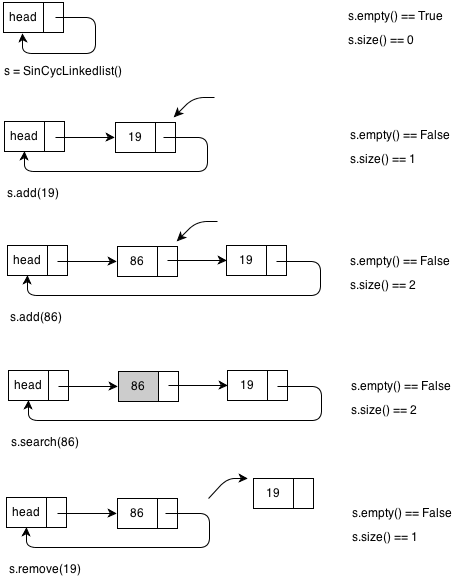本文实例讲述了Python实现的数据结构与算法之链表。分享给大家供大家参考。具体分析如下:
一、概述
链表(linked list)是一组数据项的集合,其中每个数据项都是一个节点的一部分,每个节点还包含指向下一个节点的链接。
根据结构的不同,链表可以分为单向链表、单向循环链表、双向链表、双向循环链表等。其中,单向链表和单向循环链表的结构如下图所示:

二、ADT
这里只考虑单向循环链表ADT,其他类型的链表ADT大同小异。单向循环链表ADT(抽象数据类型)一般提供以下接口:
① SinCycLinkedlist() 创建单向循环链表
② add(item) 向链表中插入数据项
③ remove(item) 删除链表中的数据项
④ search(item) 在链表中查找数据项是否存在
⑤ empty() 判断链表是否为空
⑥ size() 返回链表中数据项的个数
单向循环链表操作的示意图如下:

三、Python实现
Python的内建类型list底层是由C数组实现的,list在功能上更接近C++的vector(因为可以动态调整数组大小)。我们都知道,数组是连续列表,链表是链接列表,二者在概念和结构上完全不同,因此list不能用于实现链表。
在C/C++中,通常采用“指针+结构体”来实现链表;而在Python中,则可以采用“引用+类”来实现链表。在下面的代码中,SinCycLinkedlist类代表单向循环链表,Node类代表链表中的一个节点:
#!/usr/bin/env python
# -*- coding: utf-8 -*-
class Node:
def __init__(self, initdata):
self.__data = initdata
self.__next = None
def getData(self):
return self.__data
def getNext(self):
return self.__next
def setData(self, newdata):
self.__data = newdata
def setNext(self, newnext):
self.__next = newnext
class SinCycLinkedlist:
def __init__(self):
self.head = Node(None)
self.head.setNext(self.head)
def add(self, item):
temp = Node(item)
temp.setNext(self.head.getNext())
self.head.setNext(temp)
def remove(self, item):
prev = self.head
while prev.getNext() != self.head:
cur = prev.getNext()
if cur.getData() == item:
prev.setNext(cur.getNext())
prev = prev.getNext()
def search(self, item):
cur = self.head.getNext()
while cur != self.head:
if cur.getData() == item:
return True
cur = cur.getNext()
return False
def empty(self):
return self.head.getNext() == self.head
def size(self):
count = 0
cur = self.head.getNext()
while cur != self.head:
count += 1
cur = cur.getNext()
return count
if __name__ == '__main__':
s = SinCycLinkedlist()
print('s.empty() == %s, s.size() == %s' % (s.empty(), s.size()))
s.add(19)
s.add(86)
print('s.empty() == %s, s.size() == %s' % (s.empty(), s.size()))
print('86 is%s in s' % ('' if s.search(86) else ' not',))
print('4 is%s in s' % ('' if s.search(4) else ' not',))
print('s.empty() == %s, s.size() == %s' % (s.empty(), s.size()))
s.remove(19)
print('s.empty() == %s, s.size() == %s' % (s.empty(), s.size()))
运行结果:
$ python sincyclinkedlist.py s.empty() == True, s.size() == 0 s.empty() == False, s.size() == 2 86 is in s 4 is not in s s.empty() == False, s.size() == 2 s.empty() == False, s.size() == 1
希望本文所述对大家的Python程序设计有所帮助。
 Python: compiler or Interpreter?May 13, 2025 am 12:10 AM
Python: compiler or Interpreter?May 13, 2025 am 12:10 AMPython is an interpreted language, but it also includes the compilation process. 1) Python code is first compiled into bytecode. 2) Bytecode is interpreted and executed by Python virtual machine. 3) This hybrid mechanism makes Python both flexible and efficient, but not as fast as a fully compiled language.
 Python For Loop vs While Loop: When to Use Which?May 13, 2025 am 12:07 AM
Python For Loop vs While Loop: When to Use Which?May 13, 2025 am 12:07 AMUseaforloopwheniteratingoverasequenceorforaspecificnumberoftimes;useawhileloopwhencontinuinguntilaconditionismet.Forloopsareidealforknownsequences,whilewhileloopssuitsituationswithundeterminediterations.
 Python loops: The most common errorsMay 13, 2025 am 12:07 AM
Python loops: The most common errorsMay 13, 2025 am 12:07 AMPythonloopscanleadtoerrorslikeinfiniteloops,modifyinglistsduringiteration,off-by-oneerrors,zero-indexingissues,andnestedloopinefficiencies.Toavoidthese:1)Use'i
 For loop and while loop in Python: What are the advantages of each?May 13, 2025 am 12:01 AM
For loop and while loop in Python: What are the advantages of each?May 13, 2025 am 12:01 AMForloopsareadvantageousforknowniterationsandsequences,offeringsimplicityandreadability;whileloopsareidealfordynamicconditionsandunknowniterations,providingcontrolovertermination.1)Forloopsareperfectforiteratingoverlists,tuples,orstrings,directlyacces
 Python: A Deep Dive into Compilation and InterpretationMay 12, 2025 am 12:14 AM
Python: A Deep Dive into Compilation and InterpretationMay 12, 2025 am 12:14 AMPythonusesahybridmodelofcompilationandinterpretation:1)ThePythoninterpretercompilessourcecodeintoplatform-independentbytecode.2)ThePythonVirtualMachine(PVM)thenexecutesthisbytecode,balancingeaseofusewithperformance.
 Is Python an interpreted or a compiled language, and why does it matter?May 12, 2025 am 12:09 AM
Is Python an interpreted or a compiled language, and why does it matter?May 12, 2025 am 12:09 AMPythonisbothinterpretedandcompiled.1)It'scompiledtobytecodeforportabilityacrossplatforms.2)Thebytecodeistheninterpreted,allowingfordynamictypingandrapiddevelopment,thoughitmaybeslowerthanfullycompiledlanguages.
 For Loop vs While Loop in Python: Key Differences ExplainedMay 12, 2025 am 12:08 AM
For Loop vs While Loop in Python: Key Differences ExplainedMay 12, 2025 am 12:08 AMForloopsareidealwhenyouknowthenumberofiterationsinadvance,whilewhileloopsarebetterforsituationswhereyouneedtoloopuntilaconditionismet.Forloopsaremoreefficientandreadable,suitableforiteratingoversequences,whereaswhileloopsoffermorecontrolandareusefulf
 For and While loops: a practical guideMay 12, 2025 am 12:07 AM
For and While loops: a practical guideMay 12, 2025 am 12:07 AMForloopsareusedwhenthenumberofiterationsisknowninadvance,whilewhileloopsareusedwhentheiterationsdependonacondition.1)Forloopsareidealforiteratingoversequenceslikelistsorarrays.2)Whileloopsaresuitableforscenarioswheretheloopcontinuesuntilaspecificcond


Hot AI Tools

Undresser.AI Undress
AI-powered app for creating realistic nude photos

AI Clothes Remover
Online AI tool for removing clothes from photos.

Undress AI Tool
Undress images for free

Clothoff.io
AI clothes remover

Video Face Swap
Swap faces in any video effortlessly with our completely free AI face swap tool!

Hot Article

Hot Tools

SublimeText3 Mac version
God-level code editing software (SublimeText3)

Dreamweaver CS6
Visual web development tools

WebStorm Mac version
Useful JavaScript development tools

PhpStorm Mac version
The latest (2018.2.1) professional PHP integrated development tool

mPDF
mPDF is a PHP library that can generate PDF files from UTF-8 encoded HTML. The original author, Ian Back, wrote mPDF to output PDF files "on the fly" from his website and handle different languages. It is slower than original scripts like HTML2FPDF and produces larger files when using Unicode fonts, but supports CSS styles etc. and has a lot of enhancements. Supports almost all languages, including RTL (Arabic and Hebrew) and CJK (Chinese, Japanese and Korean). Supports nested block-level elements (such as P, DIV),






